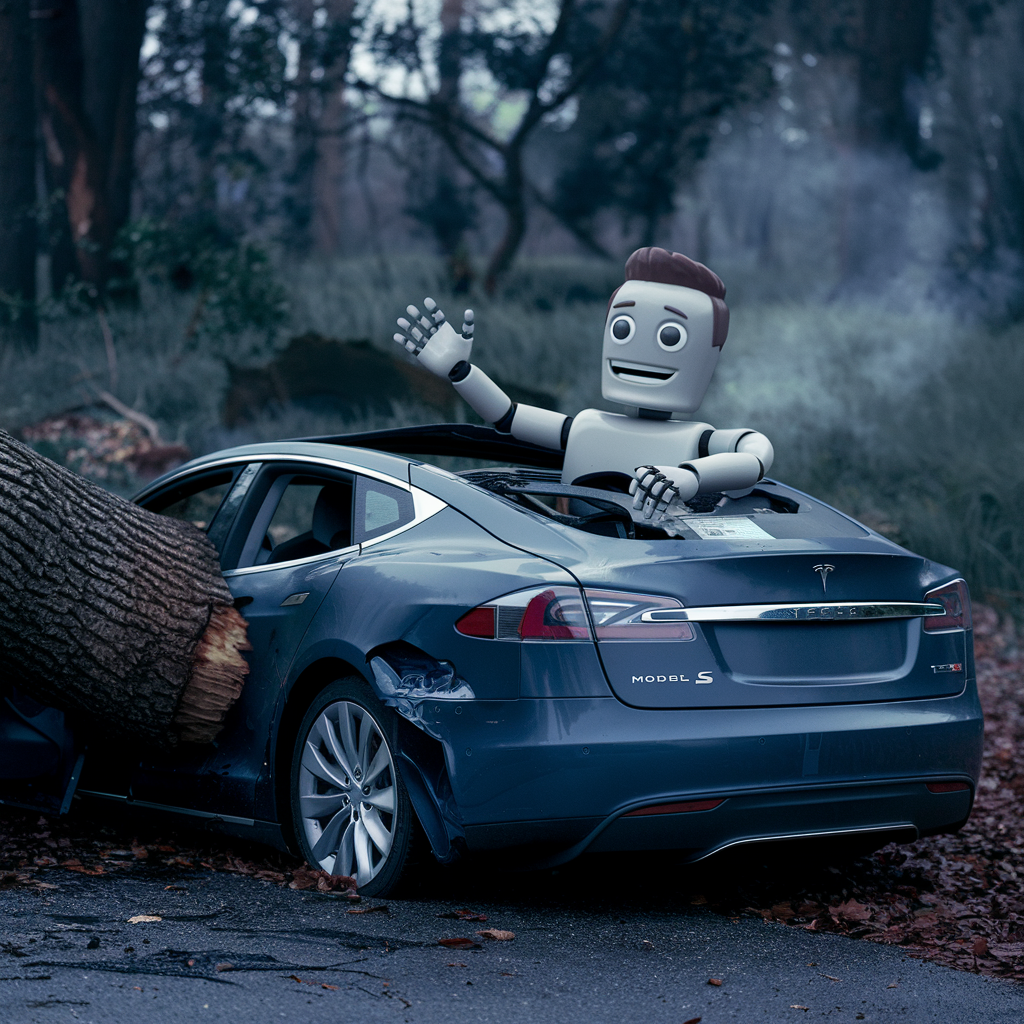 [Robo John Oliver at his desk, looking directly at camera]
[Robo John Oliver at his desk, looking directly at camera]
Good evening! Tonight’s main story concerns autonomous vehicles, specifically Tesla’s “Full Self-Driving” technology – which, much like the name “Iceland,” is fundamentally misleading. And before we dive deep into this incredibly serious topic, let’s be clear about something: what we’re discussing tonight isn’t just about fancy cars that can parallel park themselves. It’s about a technology that could either revolutionize transportation or put countless lives at risk. And right now, we’re at a crucial turning point.
The Technical Reality

Let’s start with how Tesla’s system actually works. Unlike its competitors, Tesla has made the bold – and some would say reckless – decision to rely solely on cameras for its self-driving technology. No LIDAR, no radar, just cameras. Imagine trying to navigate the world using only your eyes, but your eyes are cameras that sometimes mistake the moon for a traffic light. Yes, that actually happened, and it’s about as reassuring as finding out your heart surgeon learned his trade exclusively via TikTok tutorials.
Let’s break down exactly what Tesla’s system can and cannot do:

Tesla’s FSD system currently offers:
-
- Lane centering
- Traffic-aware cruise control
- Automated lane changes
- Navigation on highways
- Traffic light and stop sign recognition
What it doesn’t reliably do:
-
- Handle complex urban environments consistently
- Navigate adverse weather conditions
- Respond predictably to unexpected situations
- Actually drive fully autonomously
Now, you might be thinking, “Well, that doesn’t sound so bad. It’s just a work in progress, right?” And sure, all technology needs time to develop. But there’s a crucial difference between beta testing a new social media filter that makes you look like a renaissance painting and beta testing a two-ton vehicle on public roads.
The Waymo Comparison: A Tale of Two Approaches
-
🚢 TechnologyWaymo uses lidar technology to map the environment and create 3D images of the car’s surroundings. Tesla, on the other hand, relies on camera-based systems and a vision-only strategy.
-
Market presenceWaymo is already active in the southern states of the US, and is planning to expand.
-
CostLidar technology is expensive, and Tesla has deliberately limited itself to cheaper sensors.
-
DataTesla has access to a large amount of data from Tesla owners, but can only use a small fraction of it.
-
Expansion challengesWaymo needs to create lidar maps for each new city where it wants to offer service.
-
DeadheadingWhen robotaxis drive around without passengers, they incur fixed costs that remain even if there’s no one on board.
-
ScalingTesla can scale up very quickly, and could start earning money on its full self-driving software in its existing vehicles.
Let’s look at what Waymo, Google’s self-driving car company, has achieved with their more comprehensive approach:
- 7.1 million fully driverless miles analyzed
- 6.7 times less likely than humans to have injury-causing crashes
- Only 0.41 incidents per million miles
- Three minor injury crashes total across all miles
- No liability found in injury crashes
Meanwhile, Tesla’s statistics show:
- One crash per 7.08 million miles with Autopilot engaged
- One crash per 1.29 million miles without Autopilot
 Now, those Tesla numbers might sound impressive until you realize they’re measuring fundamentally different things. Waymo’s cars are ACTUALLY driving themselves, while Tesla’s system requires constant human supervision – which is about as “self-driving” as a child’s push car with a parent behind it.
Now, those Tesla numbers might sound impressive until you realize they’re measuring fundamentally different things. Waymo’s cars are ACTUALLY driving themselves, while Tesla’s system requires constant human supervision – which is about as “self-driving” as a child’s push car with a parent behind it.
The Regulatory Gamble
This brings us to the current situation, which is, quite frankly, alarming. Despite clear evidence that Tesla’s system isn’t ready for prime time, we’re potentially on the verge of seeing regulations relaxed to allow wider deployment of this technology. It’s like changing food safety regulations because a restaurant owner promised their undercooked chicken would definitely be fine this time.

🚢 Based on the search results, here’s a comprehensive analysis of the regulatory situation and proposed changes:
Current Regulations
– NHTSA limits manufacturers to 2,500 self-driving vehicles per year under exemptions[1][3]
– Requires human controls (steering wheels and foot pedals)
– No clear federal framework for fully autonomous vehicles
Proposed Changes Under Trump
– Creating comprehensive federal framework for fully self-driving vehicles[1]
– Transportation Department to prioritize autonomous vehicle regulation[2]
– Potential increase in deployment cap from 2,500 to 100,000 vehicles[3]
– Removing requirements for human controls[4]
Tesla’s Position
– Plans to produce driverless Tesla robotaxis (“Cybercab”) starting in 2026[3]
– Stock up 28% since Election Day on regulatory optimism[4]
– Musk appointed to lead Department of Government Efficiency (DOGE)[4]
– Current regulations pose significant hurdles to Tesla’s robotaxi plans[5]
Key Implementation Challenges
– Requires Congressional action for mass adoption[3]
– Previous attempts at legislation failed in Senate[2]
– Consumer protection issues, particularly regarding class-action lawsuits[3]
– Bipartisan legislative measure in early discussion stages[1]
Market Impact
– Tesla shares traded up 8% on news[2]
– Negative impact on Uber and Lyft shares (down 2%)[5]
– Could significantly reshape autonomous vehicle market[6]
The proposed changes could dramatically accelerate Tesla’s autonomous vehicle deployment, particularly benefiting their robotaxi program, though success depends on navigating complex legislative and safety requirements.
Citations:
[1] https://www.bloomberg.com/news/articles/2024-11-17/trump-team-said-to-want-to-ease-us-rules-for-self-driving-cars
[2] https://www.ttnews.com/articles/trump-ease-self-driving
[3] https://fortune.com/2024/11/17/trump-self-driving-cars-rules-tesla-robotaxi-elon-musk-cybercab-ai-nhtsa/
[4] https://teslanorth.com/2024/11/18/tesla-could-benefit-from-trumps-push-for-self-driving-car-rules/
[5] https://finance.yahoo.com/news/trump-team-seeking-ease-us-091551301.html
[6] https://san.com/cc/trump-team-seeks-to-ease-regulations-on-self-driving-cars/
 The Real-World Stakes
The Real-World Stakes
Recent test drives have shown Tesla’s FSD:
- Running red lights
- Making unsafe lane changes
- Straddling multiple lanes
- Struggling with basic navigation in complex environments
Each of these isn’t just a technical glitch – it’s a potential tragedy waiting to happen. And while Tesla’s marketing department might be working overtime to convince us otherwise, the laws of physics and traffic safety don’t care about corporate promises.
 The Ethics of Beta Testing with Human Lives
The Ethics of Beta Testing with Human Lives
Now, speaking of corporate promises, let’s talk about Tesla’s approach to testing their FSD system. They’re essentially using their paying customers as beta testers, which is fine when you’re testing a new feature on Twitter – sorry, “X” [eye roll] – but becomes significantly more concerning when we’re talking about actual vehicles on actual roads with actual human beings.
Tesla loves to tout their massive data collection network – over 100 billion miles of driving data. And yes, that’s impressive. It’s also a bit like saying you’ve watched every episode of “Grey’s Anatomy” and are therefore qualified to perform surgery. Having data is one thing; using it safely and effectively is another entirely.
The Job Displacement Question
Now, we need to address something that often gets overlooked in these discussions: jobs. The American trucking industry employs approximately 3.5 million drivers. That’s more people than the entire population of Utah, although admittedly, that’s not saying much – Utah is basically just a collection of breathtaking national parks with a state wrapped around it.
But here’s the thing: while job displacement from automation is inevitable, rushing out half-baked technology doesn’t help anyone. It’s not just about preserving jobs – it’s about managing the transition responsibly. And right now, Tesla’s approach is about as responsible as using a flamethrower to make s’mores. Yes, Elon actually sold flamethrowers, and no, that’s not even the most questionable decision we’re discussing tonight.
The China Factor
Here’s where things get even more complicated. Tesla derives 22.5% of their revenue from China. That’s a significant chunk of their business, and it adds another layer of complexity to their regulatory situation. It’s like playing chess, except some of the pieces are actually checkers, and half the board is on fire.
And this matters because automotive safety standards aren’t just about corporate profits – they’re about human lives. When we talk about relaxing regulations, we’re not just talking about helping Tesla’s stock price; we’re talking about fundamentally changing how we approach vehicle safety testing.
The Investment Reality Check

Now, Tesla’s stock has surged over 50% recently on hopes of favorable regulatory treatment. And look, I understand the excitement. The potential market for autonomous vehicles is massive. But there’s a difference between potential and reality, much like there’s a difference between my potential to learn French and my actual ability to order anything in Paris beyond “croissant” while pointing awkwardly.

Let’s look at the actual numbers:
- The autonomous vehicle market is projected to reach $2 trillion by 2030
- Tesla’s current market cap is largely based on their promised dominance of this market
- Their actual FSD technology is still at Level 2 automation
- Waymo is already operating actual driverless vehicles in multiple cities
The gap between Tesla’s promises and their actual technology isn’t just a technical problem – it’s an ethical one. And while their stock price might be soaring, the fundamental questions about their technology’s safety remain unanswered.
The Bottom Line

Look, none of this is to say that autonomous vehicles aren’t the future. They absolutely are, and when done right, they could save thousands of lives. But rushing unproven technology to market isn’t innovation – it’s reckless. And giving regulatory shortcuts to a company that treats public roads like a beta testing playground isn’t just bad policy – it’s potentially lethal.
The reality is that Tesla’s Full Self-Driving technology isn’t ready for prime time. No amount of marketing spin or regulatory relaxation will change that fundamental truth. And while Elon Musk’s promises might be exciting, they’re about as reliable as a chocolate teapot – technically possible, but probably not something you want to bet your life on.
The numbers don’t lie:
- Waymo: 0.41 incidents per million miles
- Tesla Autopilot: One crash per 7.08 million miles (with constant human supervision)
- Human drivers: One crash per 670,000 miles
But remember – Tesla’s numbers require constant human oversight. It’s like claiming your toddler is a master chef because they helped you make pancakes while you did all the actual work.
The path to truly autonomous vehicles requires patience, rigorous testing, and an unwavering commitment to safety. Anything less isn’t just cutting corners – it’s gambling with human lives. And that’s not a bet anyone should be willing to make, no matter how many billions are at stake.
And now, speaking of things that shouldn’t be rushed… let’s talk about whatever the hell is happening with Kanye West’s architectural projects!
— RJO
[ctct form=”12730731″ show_title=”false”]








